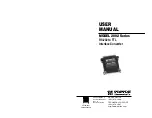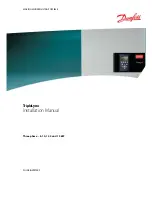
29
Analog Inputs
1
Analog Inputs
The VMIVME-3126A High Resolution, Isolated Analog-to-Digital Converter board
can accept bipolar and unipolar signals in the ranges stated in the specification. To
ensure accuracy and reduce noise, proper grounding techniques and the use of
twisted shielded pair cable is strongly recommended for the low-level ranges. The
inputs provide a high impedance in the power on or off condition. This is critical so
that the board does not load the signal source. The inputs are also over-voltage
protected with diodes connected to the power rails.
Analog-to-Digital Converter (ADC)
The Analog-to-Digital Converter (ADC) uses a sigma-delta conversion technique to
digitize input signals with up to 24-bits of no missing code performance. The ADC
also provides internal gain and digital filtering. There is one ADC per channel with all
channels updating their output registers simultaneously. A Sigma-Delta ADC uses a
1-bit analog-to-digital conversion at a very fast sample rate. This sample rate is many
times greater than the analog signal sampling frequency (oversampling).
Oversampling spreads the quantization noise over a wider frequency than the band of
interest. The noise in the passband is reduced by filtering and moving the noise
energy to frequencies outside this passband.
Programmable Gain Amplifier (PGA)
The ADC contains an internal PGA with software controlled gains of 1 to 128 in seven
binary steps. The DSP automatically selects the appropriate gain required for the
range selected.
RTD Excitation
The VMIVME-3126A is capable of supplying excitation current to Resistance
Temperature Detectors (RTDs). The excitation current is enabled under software
control by writing to the RTD bit in the desired channel’s CSR. The actual current
supplied to the RTD is determined by the connections made at the P3 or P4 input
connectors. There are two pins per channel for RTD excitation. The current on each
pin is 200
µ
A. Wiring the two pins together yields 400
µ
A of current excitation.
An RTD is essentially a resistor whose resistance value changes with temperature. A
constant excitation current produces a voltage corresponding to the resistance of the
RTD. This voltage is measured and digitized by the board. Using the digitized results,
the user can calculate the temperature knowing the temperature of the coefficient of
the RTD.
Application and configurations for RTD control are discussed in Configuration and
Installation section of this manual.
Artisan Technology Group - Quality Instrumentation ... Guaranteed | (888) 88-SOURCE | www.artisantg.com
















































